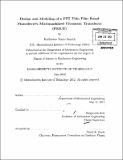Design and modeling of a PZT thin film based piezoelectric micromachined ultrasonic transducer (PMUT)
Author(s)
Smyth, Katherine Marie
DownloadFull printable version (12.18Mb)
Alternative title
Design and modeling of a lead zirconate titanate thin film based piezoelectric micromachined ultrasonic transducer (PMUT)
Other Contributors
Massachusetts Institute of Technology. Dept. of Mechanical Engineering.
Advisor
Sang-Gook Kim.
Terms of use
Metadata
Show full item recordAbstract
The design and modelling framework for a piezoelectric micromachined ultrasonic transducer (PMUT) based on the piezoelectric thin film deposition of lead zirconate titanate (PZT) is defined. Through high frequency vibration (1-16MHz) of a thin plate, the PMUT transmits and receives pressure pulses to construct medical ultrasound images as an alternative to bulk piezoelectric transducers currently in use. Existing transducers are difficult to fabricate and lack the small scale necessary for small form factor, high resolution 2D imaging arrays. From acoustic priniciples, the potential PMUT acoustic pressure output is determined and compared to a radiating rigid piston model. Acoustic pressure is shown to scale with the volumetric displacement rate, which is related to the plate deflection. A Green's function approach is then used to explicitly solve for the plate deflection of a bimorph and unimorph PMUT with an arbitrary number of circular or ring electrodes. The resulting solution is much simpler and more flexible than previously published solution techniques enabling the optimization of electrode configuration for large deflection and acoustic pressure. Additionally, the contribution of residual stress is examined; particularly its effects on bandwidth, sensitivity, and resonant frequency and an appropriate electrode coverage of the PMUT plate is suggested. Based on modelling, an initial PMUT design is proposed and is currently being fabricated.
Description
Thesis (S.M.)--Massachusetts Institute of Technology, Dept. of Mechanical Engineering, 2012. Cataloged from PDF version of thesis. Includes bibliographical references (p. 149-156).
Date issued
2012Department
Massachusetts Institute of Technology. Department of Mechanical EngineeringPublisher
Massachusetts Institute of Technology
Keywords
Mechanical Engineering.